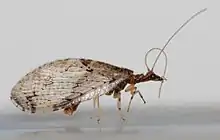| Microminae | |
|---|---|
 | |
| Micromus africanus | |
| Scientific classification | |
| Domain: | Eukaryota |
| Kingdom: | Animalia |
| Phylum: | Arthropoda |
| Class: | Insecta |
| Order: | Neuroptera |
| Family: | Hemerobiidae |
| Subfamily: | Microminae Krueger, 1922[1] |
Microminae is a subfamily of neuropteran insects of the family Hemerobiidae.[1]
Includes the genera Micromus (with global distribution), Nusalala (with Neotropical distribution), Noius[2] (New Caledonia), and Megalomina (Australia and New Guinea).[3]
The subfamily is characterized by a single unambiguous synapomorphy, male abdominal tergites 9 and 10 fused (49:1), and two homoplasious transformations (23:1 and 37:1).[4]
Recent studies place Drepanepteryginae as the sister subfamily of Microminae, with its last common ancestor estimated to have lived between 131-141 million years ago. The same study places the last common ancestor of all Microminae somewhere in between 112 and 118 million years ago.[3]
References
- 1 2 "ITIS Standard Report Page: Microminae". www.itis.gov.
- ↑ Registry-Migration.Gbif.Org (2021). "GBIF Backbone Taxonomy". GBIF Secretariat. doi:10.15468/39omei.
{{cite journal}}: Cite journal requires|journal=(help) - 1 2 Garzón-Orduña, IJ; Menchaca-Armenta, I; Contreras-Ramos, A; Liu, X; Winterton, SL (20 September 2016). "The phylogeny of brown lacewings (Neuroptera: Hemerobiidae) reveals multiple reductions in wing venation". BMC Evolutionary Biology. 16: 192. doi:10.1186/s12862-016-0746-5. PMC 5029026. PMID 27645380.
- ↑ Oswald, John D. (1993). "Revision and Cladistic Analysis of the World Genera of the Family Hemerobiidae (Insecta: Neuroptera)". Journal of the New York Entomological Society. 101 (2): 143–299.
This article is issued from Wikipedia. The text is licensed under Creative Commons - Attribution - Sharealike. Additional terms may apply for the media files.